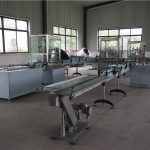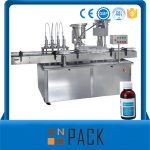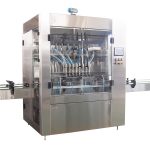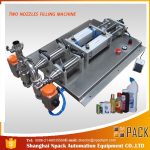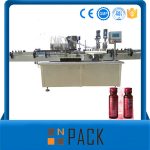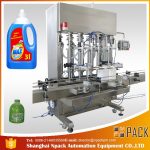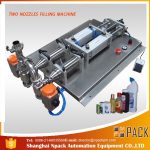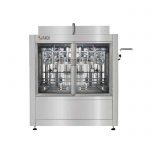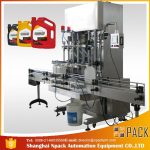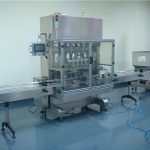
A dishwashing liquid filling machine is a type of automated equipment that is designed to fill bottles or containers with dishwashing liquid. It typically uses a series of pumps, sensors, and nozzles to accurately measure and dispense the correct amount of dishwashing liquid into each container. These machines can be used in industrial or commercial settings to increase production efficiency and accuracy.
Presupuesto
máquina de llenado de líquido para lavar platos
1. With CE Certificate,Meet the GMP
2. Material:304or316Stainless Steel
3. Pay:T/T,L/C
Descripción
CE de la UE
ISO 9001
Cumplir con los requisitos de GMP
longlife of service, low mainteinance rate
Función principal
La máquina es una máquina de llenado avanzada de alta precisión que puede completar el proceso de conteo, llenado y taponado de botellas automáticamente.
Caracteristicas
1. Compacto estructurado, atractivo, fácil de operar y altamente automatizado.
2. Los componentes en contacto con el material están hechos de acero inoxidable, fáciles de limpiar.
3. El volumen de llenado se controla con válvulas de película para garantizar la precisión.
4. Las válvulas de llenado de alta velocidad y alta precisión aseguran que no haya fugas.
5. Está equipado con un sistema de alimentación de tapa de alta efectividad.
Opción de idioma
Monitor language: English, Spanish, Arabic, Portuguese, Russian, Italian, French, Korean.
Principales características:
1. Linear type piston filling machine special designed for sticky liquid,such as detergent, shampoo, lotion,lubricant oil,edible oil, etc. international advanced technology, already approved by well-known companies such as Bayer. High filling accuracy, simple structure, stable working, widely application. Counting of bottles inlet, qualitative filling, bottles outlet are done automatically.
2. Not only the whole 13 filling nozzles dosage can be rough adjusted, but also each single filling nozzles dosage can finely adjusted.
3. Puede memorizar muchos parámetros, útiles para diversas especificaciones cambiadas, todas las dosis de llenado se pueden ajustar mediante pantalla táctil.
4. Liquid control for normal working liquid level control, sound and light alarm device, guarantee the liquid level at normal condition; also can achieved for inlet valve/pump control.
5. Material outlet joints all adopts quick-assembling type (clamp type), easily for clean. Sealing gaskets adopts fluorine rubber O-ring; sanitary connecting pipes.
6. With protection case, drip gutter, main materials are made of SS304, wetted parts are made of SS316L.
Parámetro técnico principal
| ít | Nombre | Parámetro técnico |
| 01 | Dimensión de la máquina (L * W * H) | 2200mm * 1400mm * 2800mm |
| 02 | Peso de la máquina | Cerca de 1400 kg |
| 03 | Diámetro interno de apertura del contenedor | ≥φ35mm |
| 04 | Contenedor adecuado | 1 litro .2 litro |
| 05 | Altura del contenedor | 80-350mm |
| 06 | Fuente de alimentación | AC 380V; 50HZ |
| 07 | Poder | 5Kw |
| 08 | Precisión de llenado | ≤ ± 1% |
| 09 | Fuente de aire | 0.6Mpa aire comprimido estable y limpio |
| 11 | Número de boquillas de llenado | 13 |
| 12 | Altura del transportador | 900 mm ± 50 mm |
| 13 | capacidad | ≤3200 botellas / hora (tome agua como prueba) |
| 14 | Botella en dirección de alimentación | De izquierda a derecha |
Detalles Rápidos
Tipo: máquina de llenado
Estado: Nuevo
Aplicación: Química
Tipo de embalaje: Botellas
Material de embalaje: madera
Grado automático: automático
Tipo conducido: neumático
Voltaje: 220v
Poder: 3KW
Lugar de origen: Shanghai. China (continental)
Nombre de la marca: NPACK
Dimensión (L * W * H): 2200 mm * 1400 mm * 2800 mm
Peso: 1400
Certificación: CE
Servicio postventa proporcionado: ingenieros disponibles para dar servicio a maquinaria en el extranjero
material: SS304
PLC: Panasonic
Pantalla táctil: Panasonic
Dishwashing liquid filling machines are specifically designed to package dishwashing liquids into various types of containers. These machines are essential for businesses in the cleaning industry who want to streamline their packaging process and increase their productivity. There are several types of dishwashing liquid filling machines available in the market, each with its unique features and benefits.
One of the most popular types of dishwashing liquid filling machines is the volumetric filler. This machine operates on the principle of displacement and uses a piston to fill the containers with the precise amount of liquid required. This type of machine is highly accurate and is suitable for packaging liquids with a constant viscosity.
Another type of dishwashing liquid filling machine is the gravity filler. This machine works on the principle of gravity and uses a funnel to fill the containers with the liquid. The liquid is then dispensed into the containers based on the height of the liquid in the funnel. This type of machine is ideal for packaging low viscosity liquids and is very cost-effective.
The third type of dishwashing liquid filling machine is the overflow filler. This machine works on the principle of overflow and uses a hopper to fill the containers with the liquid. The liquid is then dispensed into the containers based on the height of the liquid in the hopper. This type of machine is ideal for packaging high viscosity liquids and can handle liquids with large particles.
When choosing a dishwashing liquid filling machine, it is important to consider factors such as the size of your production line, the viscosity of the liquid, the type of containers you will be using, and the speed of production you require. It is also important to consider the ease of maintenance and the reliability of the machine.
In conclusion, a dishwashing liquid filling machine is a crucial investment for businesses in the cleaning industry. With the right machine, businesses can increase their productivity, improve the quality of their packaging, and save time and money. When choosing a dishwashing liquid filling machine, it is important to consider factors such as the size of your production line, the viscosity of the liquid, the type of containers you will be using, and the speed of production you require.
